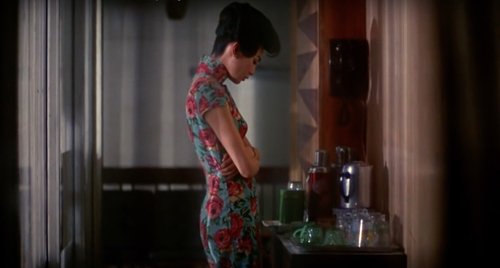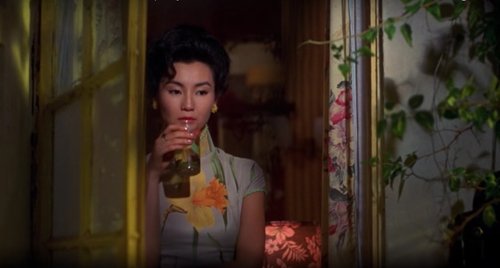In the Mood for Qipaos
 I don’t remember what first inspired my admiration for the traditional Chinese cheongsam, or qipao – very likely a Chinese film – but I am sure it had a lot to do with the sumptuous silk embroidered fabric that many are made from. Many years ago I once owned a beautiful example made from oyster-hued silk, embroidered heavily in red, silver and gold. Unfortunately it was a little small for me, and I stupidly culled it from my wardrobe in a mad fit of minimalism in my late 20s, since I thought I would never wear it. Ever since then I have been looking for a new one.
I don’t remember what first inspired my admiration for the traditional Chinese cheongsam, or qipao – very likely a Chinese film – but I am sure it had a lot to do with the sumptuous silk embroidered fabric that many are made from. Many years ago I once owned a beautiful example made from oyster-hued silk, embroidered heavily in red, silver and gold. Unfortunately it was a little small for me, and I stupidly culled it from my wardrobe in a mad fit of minimalism in my late 20s, since I thought I would never wear it. Ever since then I have been looking for a new one.
 Qipao of the Daoguang Period (1821–1850); Empress Xiaoshen, image from WikipediaThe history of the qipao is long and complicated, and (according to Wikipedia) its origins are controversial. Generally people believe that its origin is in the Qing dynasty (1644–1912), but some scholars argue that in fact the cheongsam was first worn two millennia prior, in a period between the Western Zhou dynasty (1046BC–771BC) and the pre-Qin era (221BC–207BC). Whatever is the truth, the qipao of the Qing dynasty could not be more different from the style common today. It was floor-length and loose, and cut in an A-line that revealed the figure not at all. Only the head, hand and the tips of the toes were visible.
Qipao of the Daoguang Period (1821–1850); Empress Xiaoshen, image from WikipediaThe history of the qipao is long and complicated, and (according to Wikipedia) its origins are controversial. Generally people believe that its origin is in the Qing dynasty (1644–1912), but some scholars argue that in fact the cheongsam was first worn two millennia prior, in a period between the Western Zhou dynasty (1046BC–771BC) and the pre-Qin era (221BC–207BC). Whatever is the truth, the qipao of the Qing dynasty could not be more different from the style common today. It was floor-length and loose, and cut in an A-line that revealed the figure not at all. Only the head, hand and the tips of the toes were visible.
 Chinese singer and actress Zhou Xuan wearing a cheongsam in 1930s in Shanghai; C.H. Wong Photo Studio; Image from WikipediaIn China, women’s liberation had as much effect as it had in other parts of the world at the turn of the 20th century, and the Republican period (1912–1949) is known as the golden age of the cheongsam. It is from this era that the cheongsam as we know it took form. Along with the ending of traditional foot binding, women began to bob their hair, and took to wearing this formerly exclusively masculine attire: one-piece clothing called Changshan or changpao. Now, too, the style was influenced by western fashion – the body-skimming bias-cuts popularised by Hollywood stars – hugging the figure, with hemlines gradually rising and formerly merely practical splits running much higher.
Chinese singer and actress Zhou Xuan wearing a cheongsam in 1930s in Shanghai; C.H. Wong Photo Studio; Image from WikipediaIn China, women’s liberation had as much effect as it had in other parts of the world at the turn of the 20th century, and the Republican period (1912–1949) is known as the golden age of the cheongsam. It is from this era that the cheongsam as we know it took form. Along with the ending of traditional foot binding, women began to bob their hair, and took to wearing this formerly exclusively masculine attire: one-piece clothing called Changshan or changpao. Now, too, the style was influenced by western fashion – the body-skimming bias-cuts popularised by Hollywood stars – hugging the figure, with hemlines gradually rising and formerly merely practical splits running much higher.
While the Communist Revolution virtually ended the popularity of the cheongsam, Shanghainese emigrants and refugees took the fashion with them to Hong Kong and Taiwan, and kept the style alive there.
 Maggie Cheung in Wong Kar Wai's In the Mood for Love, 2000
Maggie Cheung in Wong Kar Wai's In the Mood for Love, 2000 Maggie Cheung in Wong Kar Wai's In the Mood for Love, 2000Wong Kar Wai’s beautiful and bitter-sweet film In the Mood for Love is based on the Shanghai diaspora from the Revolution, and is set in Hong Kong in 1962. Its heroine, played by Maggie Cheung, wears a gorgeous collection of cheongsams – I remember seeing the film in the cinema when it was released in 2000, and I found the costumes no less breathtaking than the cinematography.
Maggie Cheung in Wong Kar Wai's In the Mood for Love, 2000Wong Kar Wai’s beautiful and bitter-sweet film In the Mood for Love is based on the Shanghai diaspora from the Revolution, and is set in Hong Kong in 1962. Its heroine, played by Maggie Cheung, wears a gorgeous collection of cheongsams – I remember seeing the film in the cinema when it was released in 2000, and I found the costumes no less breathtaking than the cinematography.
 I was very excited when I finally found my new cheongsam, on my Day of Yellow Bonanza, the miraculous Saturday a few months ago when I found several yellow items scattered in thrift stores across Melbourne, including a 1940s ballgown. The cheongsam is made from a luminous pale-yellow brocade of chrysanthemums, which is a popular flower in Chinese culture. It is one of four seasonal symbolic flowers representing autumn, and is also the flower of the ninth moon. The dress probably dates from the 60s, and the fabric is rayon. It actually needs to be tailored to fit me a bit better, which is why you see me with hands on waist to disguise the bagginess there. I am wearing it with a pair of patent yellow stilettos by Aldo, also found in a thrift store.
I was very excited when I finally found my new cheongsam, on my Day of Yellow Bonanza, the miraculous Saturday a few months ago when I found several yellow items scattered in thrift stores across Melbourne, including a 1940s ballgown. The cheongsam is made from a luminous pale-yellow brocade of chrysanthemums, which is a popular flower in Chinese culture. It is one of four seasonal symbolic flowers representing autumn, and is also the flower of the ninth moon. The dress probably dates from the 60s, and the fabric is rayon. It actually needs to be tailored to fit me a bit better, which is why you see me with hands on waist to disguise the bagginess there. I am wearing it with a pair of patent yellow stilettos by Aldo, also found in a thrift store.
Read more about the history of the qipao here, and about Maggie Cheung’s wardrobe for the sublime film In the Mood for Love here – I am inspired to watch it again.
 Maggie Cheung in Wong Kar Wai's In the Mood for Love, 2000
Maggie Cheung in Wong Kar Wai's In the Mood for Love, 2000
Photos: August 2018

